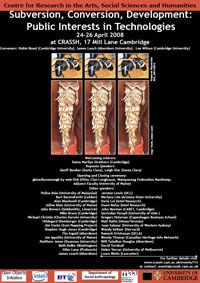 Subversion, Conversion, Development: Public Interests in Technologies took place at CRASSH (Centre for Research in the Arts , Social Sciences, and Humanities) at the University of Cambridge, 24-26 April 2008. The organizers included James Leach, Lee Wilson, Robin Boast, and Anna Malinowska.
Subversion, Conversion, Development: Public Interests in Technologies took place at CRASSH (Centre for Research in the Arts , Social Sciences, and Humanities) at the University of Cambridge, 24-26 April 2008. The organizers included James Leach, Lee Wilson, Robin Boast, and Anna Malinowska.
This site contains selected biographies and abstracts for participants in the conference. All tags were algorithmically generated by the ThoughtMesh software.
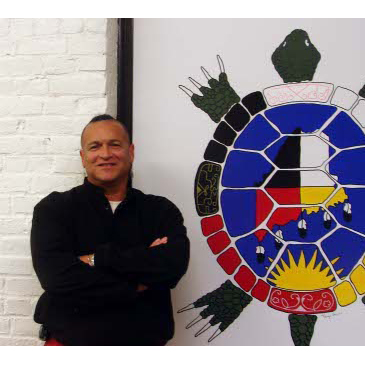 gkisedtanamoogk brings to this meeting a background in finding creative ways to bridge the socio-political polarization of the Indigenous Nations of Turtle Island and the newcomer nation-states of North America. His professional background is in human and community development and his interests include Law, History, and Spirituality. He is Wampanoag from the Federation of the Pokaunauket and practices the Ceremonial Life of his People; he is Otter and Turtle Clan; married with three Children; Education and Cultural Specialist and co-founder of the Anikwom Wholelife Center in Maine, whose work and proximity correlates to the Wabanaki Confederacy Territories. gkisedtanamoogk is currently a Still Water Research Fellow and adjunct faculty at the University of Maine at Orono.
gkisedtanamoogk brings to this meeting a background in finding creative ways to bridge the socio-political polarization of the Indigenous Nations of Turtle Island and the newcomer nation-states of North America. His professional background is in human and community development and his interests include Law, History, and Spirituality. He is Wampanoag from the Federation of the Pokaunauket and practices the Ceremonial Life of his People; he is Otter and Turtle Clan; married with three Children; Education and Cultural Specialist and co-founder of the Anikwom Wholelife Center in Maine, whose work and proximity correlates to the Wabanaki Confederacy Territories. gkisedtanamoogk is currently a Still Water Research Fellow and adjunct faculty at the University of Maine at Orono.
At James Leach's suggestion, gkisedtanamoogk conducts an experimental "ceremony" to begin and conclude this conference over a special videolink. He also participates in a demonstration of the Distant Neighbor Protocol, an innovative protocol for the responsible sharing of local knowledge with remote people.
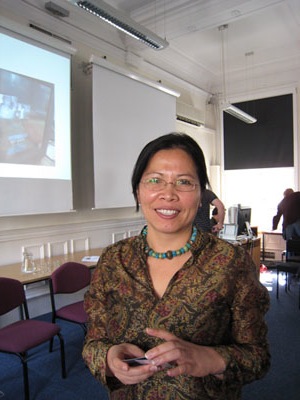 Poline Bala (Faculty of Social Science Centre of Excellence for Rural Informatics, University Malaysia Sarawak)
Poline Bala (Faculty of Social Science Centre of Excellence for Rural Informatics, University Malaysia Sarawak)
Redeploying Technologies: ICT for Greater Agency and Capacity for Political Engagement in the Kelabit Highlands
This paper examines why and how the Kelabit in Central Borneo engaged with the electronic Bario (e-Bario) development initiative. It explores how aspects of Kelabit society and history provide the context for implementation of the project and constitute a rationale for present-day attitudes to social change and the future among the Kelabit. This, I suggest, highlights the basis for adoption and application of ICT in the Kelabit Highlands. Conversely, looking at e-Bario, this paper sheds some light of how the Kelabit use ICT to facilitate greater agency and capacity for political engagement in a wider economic and political terrain.
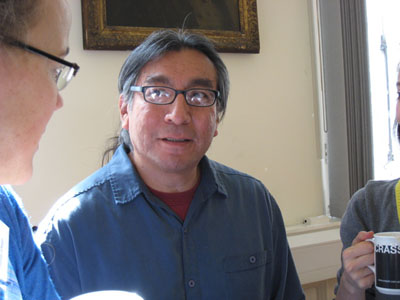 Jim Enote (A:shiwi Map Art Project)
Jim Enote (A:shiwi Map Art Project)
Gathering community around mapping projects
With local organizational know-how, sensitive inquiry and attention to Zuni visualization, the A:shiwi Map Art project puts mapping in the hands of non- technicians while adding layers of cultural and artistic involvement in the mapping process.
Many indigenous communities and their governments including Zuni are creating maps. However, nearly all these maps are being developed as computer-generated maps that will become part of geographic databases. Alternatively, the A:shiwi Map Art Project works towards communicating geography through art, essentially working with Zuni artists and cultural advisors to turn art into action.
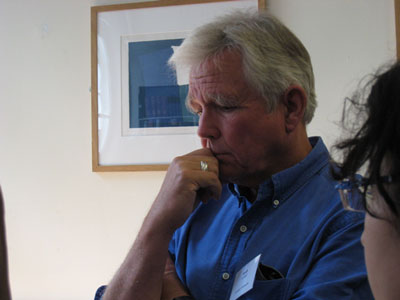 David Turnbull (University of Melbourne)
David Turnbull (University of Melbourne)
Distributed, Dialogical and Diverse: Emergent Processes in Biology, Knowledge Production and Creativity
This paper examines the ways in which the organismal and the narratological meet in cyberspace. Drawing on recent thinking about complex adaptive systems and about narrative and movement in the construction of knowledge, place and space, it considers the possibilities offered by ICT for establishing a creative commons in which differing and incommensurable ontologies can work together and in which new forms of knowledge making can emerge. It looks specifically at examples of indigenous cartographies and emergent mapping, genetic networks and story-weaving, in which the distributional, the dialogical and the diverse are key emergent processes in the creation of new knowledge.
 Jerome Lewis (Department of Anthropology, University College London)
Jerome Lewis (Department of Anthropology, University College London)
Re-presenting the world - the production of maps by non-literate hunter- gatherers as a way of communicating their world to outsiders
This paper describes how Congolese forest hunter-gatherers have found new ways to communicate their priorities to powerful outsiders who normally never consider their interests. Their traditional forest areas and resources have been attributed by central governments to multi-national industrial forestry companies. Designed together with an anthropologist and software engineer, local forest peoples developed icon-driven software that enables them to use a palm-top computer attached to a GPS to map their forest use and key resources.
This new technology is used intuitively by these non-literate people to produce maps that have become a new language with which they have established a dialogue with people who normally ignore their interests. Using maps as the means of communication, their values, needs and concerns are suddenly being treated equally to the objectives and needs of these hugely powerful and highly educated professional managers and bureaucrats.
The concept has now been redeployed to monitor illegal logging of key community resources among other groups of hunter-gatherers in Cameroon. These communities' are having vital tree resources raided by timber pirates with protection form local officials. The maps communities produce are being sent by satellite to a web-site so that a series of alliances with powerful groups in the capital can act to pressure the authorities responsible for enforcing forestry law to work more efficiently.
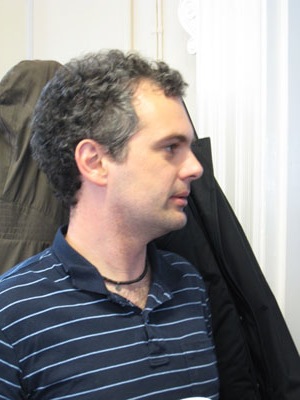 Matthew Jones (Future Interaction Technology Lab, Swansea University)
Matthew Jones (Future Interaction Technology Lab, Swansea University)
Narrowcast Yourself - User Generated Content and a Rural Indian Village
The StoryBank project is examining technologies and practices to allow digitally impoverished communities to take part in the user-generated content revolution. The approach involves combining mobile phones to create audio-visual stories and a touch screen display situated in a community meeting place. In the talk we'll consider how our experiences of working with a rural Indian village community influenced design processes, principles and prototypes. The work highlights the value of community-centred design practices and prototypes in such developing-world contexts.
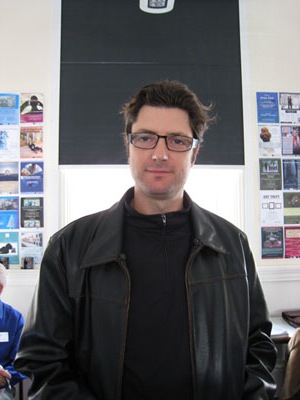 Juan Francisco Salazar (Centre for Cultural Research, University of Western Sydney)
Juan Francisco Salazar (Centre for Cultural Research, University of Western Sydney)
Maps as media for social change
The paper theorizes recent developments in participatory community mapping as both a form of social and cultural development in its own right, and a form of new media. The paper argues that mapping may be considered as poetic media practices through which Indigenous and community organizations fight back to obtain legal recognition of ancestral territories and access to environmental and cultural resources. Furthermore, the paper speculates with the idea that mapping is an emerging form of narrating place and identity, with similarities and differences to other forms of audiovisual media. Like other media forms (radio, video, Internet) maps are instruments of visual communication where complex issues of visualization and representation are at stake. In many cases, maps can play an important role as instruments of resistance and can be regarded as a novel form of media practice aimed at fostering social change. The ways through which radio and video have allowed Indigenous groups to speak and shoot back to mainstream media have been well documented. Consequently, the paper discusses new mapping for change practices that can be thought of in terms of strategies of 'mapping back' to national states and large transnational corporations.
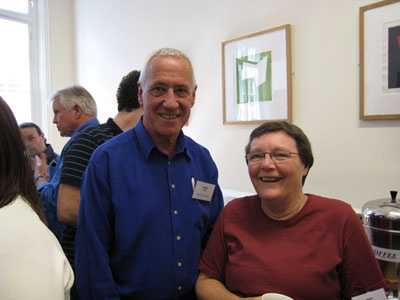 Michael Christie (School of Education, Charles Darwin University) and Helen Verran (School of Philosophy, University of Melbourne)
Michael Christie (School of Education, Charles Darwin University) and Helen Verran (School of Philosophy, University of Melbourne)
Indigenous Knowledge and Resource Management in Northern Australia: Non-coherence as a Virtue
Ours is a story of an Australian Research Council funded project involving Aboriginal knowledge communities, resource management, and digital technologies. We argue that in this work it is a virtue to promote non- coherence, both epistemic and ontic. In our presentation we will use our project website www.cdu.edu.au/centres/ ik/ to show how non-coherence can work in supporting Aboriginal methodologies while also interrupting and resisting the (Western) epistemological and ontological values native to computers and other digital technologies. The following article details one of our case studies and can be considered as preliminary reading for our presentation. Helen Verran and Michael Christie, "Using/Designing Digital technologies of representation in Aboriginal Australian Knowledge practices" Human Technology, Vol 3(2), May 2007, 214-227. www. humantechnology.jyu.fi/current/
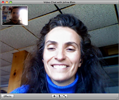 Joline Blais (University of Maine)
Joline Blais (University of Maine)
Request For Ceremony
RFC (Request For Ceremony) cordova.asap.um.maine.edu/~blaisj/rfc is a call for individuals to re-connect to the land around them by inventing ceremonies to accompany moments from their daily lives. In a deliberate echo of the 'Requests for Comments' that generated the protocols now governing today's Internet, RFC takes the form of an online community repository. In keeping with the project's focus on the earthly rather than the ethereal, Still Water's repository includes categories such as Home and Healing rather than Telnet and TCP.
Contributions to RFC to date include a ceremony devised by gradeschool kids for healing pruned trees, a birthday walk conducted by a Montessori teacher, and a tattoo ritual by a college student intent on warding off stereotypical body images. To expose relationships among these diverse ceremonies, RFC deploys a tag cloud based on ThoughtMesh tagging software.
Intended to explore the ways indigenous hands might twist digital tools, RFC aims to connect the World Wide Web with the Web of Life. In doing so, RFC reminds us that the roots of 'protocol - the diplomatic rituals that reinforce alliances among different sovereigns - lie in older ceremonial forms aimed at promoting the kinship of all beings. RFC is produced as part of Still Water's ongoing LongGreenHouse longgreenhouse.wordpress.com initiative, devoted to fostering ties between sustainable and indigenous cultures.
 Dawn Nafus, Research Anthropologist, Intel Labs
Dawn Nafus, Research Anthropologist, Intel Labs
Dr. Dawn Nafus is a research anthropologist with the People and Practices Research Group (PaPR) at Intel Labs in Portland, Oregon. Nafus holds a D.Phil in Anthropology from Cambridge University, and she previously worked as a research fellow at the Institute for Social and Technical Research at the University of Essex. She has published widely on communication technology and society. Her recent work has focused on communication technology and its relation to time, mobility, and gender.
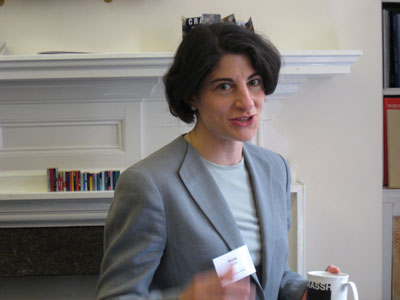
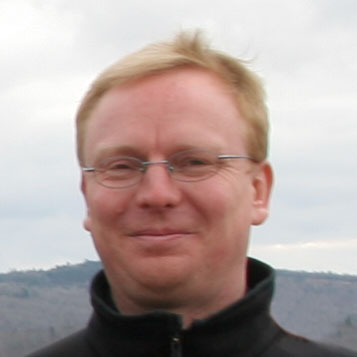 James Leach (Social Anthropology, University of Aberdeen)
James Leach (Social Anthropology, University of Aberdeen)
Wendy Seltzer Berkman Centre (Harvard University)
Cross Cultural Partnership Agreement Template
The cross-cultural partnership template is designed to help potential collaborators to reach understanding and agreement on the terms of their collaboration. In many contexts people look to the law to establish or enforce a 'safe space' in which collaborative relationships may flourish. Good intention is more fundamental than law or codes of conduct. Nonetheless, legal agreements and faith in the law can facilitate the establishment of relationships where trust is yet to be established. This presentation will showcase a template for agreement which draws upon the law: the result of long-term consideration of issues around collaboration in different situations and arenas. The template draws specifically and intentionally upon understandings abstracted from established social practices and from licenses developed for digital creations. Copyleft (an example of a license for digital creations) has built its alternative upon the scaffolding of copyright law to achieve goals outside of that law's usual bounds. For the exchange of knowledge and creative partnerships (including between indigenous peoples, corporations and institutions, different disciplinary actors, etc.) we draw upon frameworks from the area of the law pertaining to partnership. As in business dealings, choosing the partnership form brings with it default terms of fairness between partners: duties of loyalty, of care, of disclosure, of good faith and fair dealing. We seek to import those ethics and their underlying law to relationships broader than business, giving legal force to terms of mutual respect and mutually beneficial interchange. Although the Gnu GPL and Creative Commons licenses served as models, this template agreement is much more skeletal in form. That is because the core of the partnership relationship is parties jointly articulating their intentions and goals. The process of specifying terms in this agreement can be an important part of building the shared understanding that will assist the relationship to achieve mutually agreeable ends. Experience points to the significance of considering and accommodating the expectations, interests, and location of parties to a collaboration as an ongoing aspect of the relationship itself.
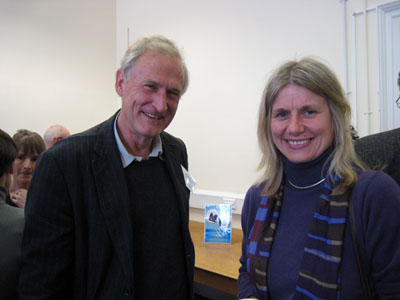 Hildegard Diemberger & Stephen Hugh-Jones, (University of Cambridge)
Hildegard Diemberger & Stephen Hugh-Jones, (University of Cambridge)
Tibetan and Mongolian Ancient Scriptures in a Digital Age
Tibetan and Mongolian texts are being rediscovered, catalogued and scanned in libraries, museums and monasteries around the world. Taking place in different social and cultural contexts, these activities aim to explore new forms of archiving and retrieval, to improve access, and to reconstitute collections, volumes and texts that have been broken up and dispersed; they also form part of the revival of Tibetan Buddhism and the preservation of cultural heritage, often after political disruption and religious persecution. New digital technologies, by facilitating the reproduction and distribution of texts, have had an enormous impact in this process with significant cognitive, cultural and political consequences. This paper will present the recently completed Tibetan-Mongolian Rare Books and Manuscripts Project and other projects funded by the AHRC and the British Library, hosted by the Mongolia and Inner Asia Studies Unit at the University of Cambridge. The aim of the initial project was to enhance the preservation, availability and understanding of some 2,500 Tibetan and Mongolian books and manuscripts held in British libraries including the entire Younghusband collection, some 1,500 volumes gathered by the British scholar-soldier Francis Younghusband during the 1903 invasion of Tibet. This was soon followed by spin-off projects that linked up several similar enterprises in Tibet, Mongolia and Bhutan and enhanced co-operation with projects in the UK. With the creation of large interconnected databases, the accessibility of texts has acquired an unprecedented dimension. However, in this paper we will also raise some of the dilemmas of digitisation as a transnational medium for archiving and dissemination.
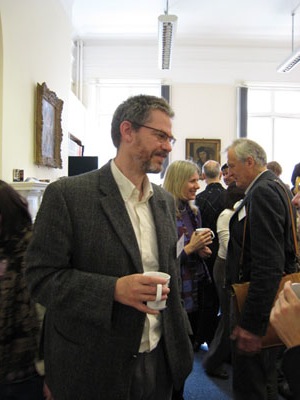 Will Tuladhar-Douglas (University of Aberdeen)
Will Tuladhar-Douglas (University of Aberdeen)
Technologies are busting with implicit intentions: the cases of writing
Technology is not merely, or even mostly, about making new things. Rather, it should be understood as a bundle of attitudes that come to cluster around an historically contingent engineered innovation so as to create a self- perpetuating social form. After considering the obvious example of the car, I will consider 'literacy' in depth. This is usually thought to be one technology, but I will show that in fact there are numerous literacies that emerge from the enmeshing of prior attitudes-often religious-and the innovation of writing.
In the spirit of the event, I will begin with one well-defined example, the ritual use of Buddhist sacred texts in the Himalayas. Newars construct mandalas from their handwritten Sanskrit manuscripts to the present day. They recite these manuscripts in a dismembered way that viscerally disgusts their Shaiva competitors. Tibetans, armed with a vast array of translations and original works in Tibetan, took up block printing soon after its invention and made it the cornerstone of a rich ritual practice including prayer wheels from the tiny to the huge, printing on water, and other deliberately short-lived acts of writing. Interestingly, the two communities were aware of each other's writing practices and technologies; but while the Newars used printing technology to make coins they resisted print until about 1900, and still strongly privilege the hand-written over the printed.
I will then apply lessons from the Himalayan case to cyberspace - the proliferation of ritualized forms of writing such as leetspeak, geek codes and Perl stanzas - and inquire as to their social embedding and effects.
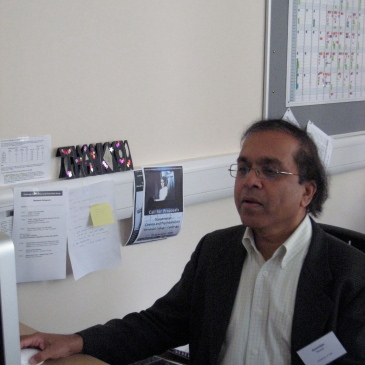 Govindan Parayil (University of Oslo)
Govindan Parayil (University of Oslo)
The Capabilities to Bridge the Digital Divide: The Missing Link in Connecting Rural India
India is shining for those connected to its extraordinarily successful ICT industries clustered in a few urban centres, while the vast majority of Indians living in more than 600,000 villages remain poor and unconnected to the 'information economy'. While large numbers of Internet kiosks have been set up during the past five years in many rural areas through various public- private initiatives, these projects have hardly made a dent in bridging the digital divide. In the general policy consensus, the digital divide is more often seen as a mere technological access problem - a problem of poor telecom infrastructure, Internet connectivity, low computer availability, and so on. We argue that this is a rather limited view of the digital divide discourse. Access to ICTs and access to the information that ICTs provide are necessary to bridge the digital divide, but they are not sufficient. Combining empirical evidence, gathered through field surveys conducted in two rural locations in the Indian states of Andhra Pradesh and Kerala, with Amartya Sen's concepts of agency and capabilities, we argue that more crucial than access are the capabilities - on the part of the individuals and society at large - to use ICTs and to convert the information that ICTs provide into useful knowledge. And the digital divide is part of a larger developmental problem in which vast sections of the world's population are deprived of these capabilities; these capabilities can only be created through large-scale complementary interventions in social development measures.
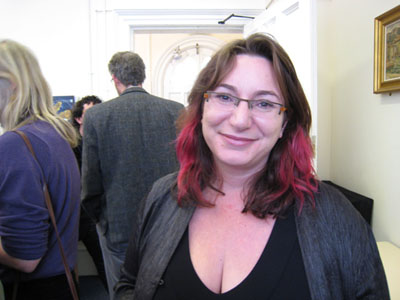 Beth Kolko (Berkman Center for Internet and Society, Harvard Law School)
Beth Kolko (Berkman Center for Internet and Society, Harvard Law School)
ICT in Central Asia
Beth Kolko is an Associate Professor in the Department of Technical Communication at the University of Washington. She was previously a professor of English at the University of Wyoming and the University of Texas at Arlington.
Her current research further develops the idea of diversity and technology by focusing on Internet development in Central Asia. Currently funded by the National Science Foundation, the Central Asian Information and Communications Technology project (http://depts.washington.edu/caict) applies theory-based analyses of culture and technology in order to concretely investigate how technology is being used in diverse communities and how such technologies change the cultures in which they adopted. The current phase of the project includes qualitative and quantitative longitudinal studies in the five Central Asian republics (Kazakhstan, Kyrgyzstan, Tajikistan, Turkmenistan, Uzbekistan). See the project website for more information.
In addition to her work on ICT and development, Kolko also leads a research group on digital games. This group is currently working in two areas: (1) cross-cultural investigations of multiplayer games, and (2) research on gender and educational games. For more information, see the project website.
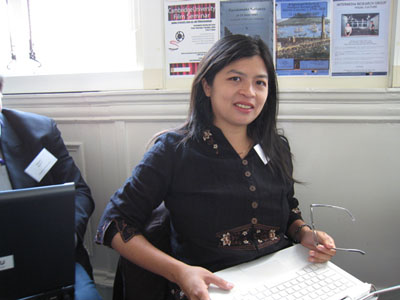 Merlyna Lim (Consortium for Science, Policy & Outcomes, Arizona State University)
Merlyna Lim (Consortium for Science, Policy & Outcomes, Arizona State University)
The Internet and Civil Society Activism in Indonesia
A decade after its emergence as a popular global medium, the Internet is now integral to socio-political realms of society. If the Internet has been embraced by politicians and civil society entities, does it succeed in fulfilling the visions of its early 90s boosters? In other words, does the Internet form a new public sphere or does it merely perpetuate the existing conditions? This presentation does not attempt to find a definitive answer as to whether or not the Internet promotes democracy or if it is a new public sphere. Using some prominent examples from the Indonesia, it explores on the dynamics and complexities of cyber civic spheres. This presentation argues that the Internet is a convivial milieu in which various civic uses are thriving and new tools for social criticism and commentary are emerging. It is shown by comparing online efforts to promote deliberative democracy and democratic mobilization to understand how civil societies are using the Internet to advance democracy. And second, looking at blogging and remix, new types of civic participation classifiable neither as mobilization nor as deliberation. This presentation demonstrates that the most vibrant political activities in cyberspace emerge in overlapped domain of politics and culture, simultaneously among multiple layers of social networks, between multiple networks of individuals, and between individuals and collectives, creating spheres of civic networks.
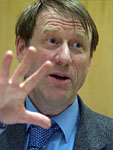 Tim Ingold (Social Anthropology, University of Aberdeen)
Tim Ingold (Social Anthropology, University of Aberdeen)
Response to Keynote, Reflections on the day
Bio: Professor Ingold has carried out ethnographic fieldwork among Saami and Finnish people in Lapland, and has written extensively on comparative questions of environment, technology and social organisation in the circumpolar North, as well as on evolutionary theory in anthropology, biology and history, on the role of animals in human society, and on issues in human ecology. His recent research interests are in the anthropology of technology and in aspects of environmental perception. He is currently writing and teaching on the comparative anthropology of the line, and on issues on the interface between anthropology, archaeology, art and architecture. His latest book, Lines: A Brief History, was published by Routledge in 2007.
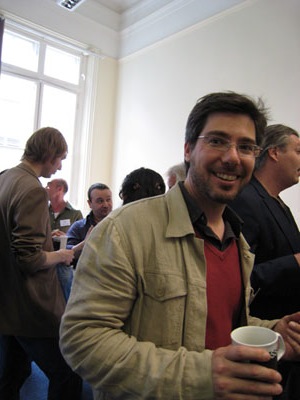 Matt Ratto (Research Fellow, HUMlab/Department of History of Ideas, Umea University and Faculty of Information Studies, University of Toronto)
Matt Ratto (Research Fellow, HUMlab/Department of History of Ideas, Umea University and Faculty of Information Studies, University of Toronto)
Critical thinking and critical making: conceptualizing material engagement and knowledge
Abstract This paper puts two seemingly contradictory concepts of knowledge and objectification in dialogue, comparing the problems described by Geoffrey Crossick as the 'widgetization' of knowledge to Star and Griesemer's concept of 'boundary object.' While both focus on how knowledge relates to material artifacts, the former sees this relationship as potentially problematic, whereas the latter conceptualizes material objectification as resulting in new possibilities for exchange and communication. I use these two positions to describe a methodological starting point for understanding the various relationships between materiality and knowledge, starting from the idea that material engagement affords at least three related forms of knowledge practice; transactive, performative, and enactive. Using examples drawn from a study of design student projects (carried out at the Umea Institute of Design from 12/2007-2/2008,) I explore the ways material affordances and practices of 'making' encourage and allow transactions between and across institutional roles and boundaries, create possibilities for community performances, and provide resources for individual enacted development. I'll end by briefly describing how a model of knowledge that encompasses these three dimensions of materiality can help us better understand how the creation of material artifacts provide resources for individuals, communities, and institutions to think through complex issues, reproduce cultural relations, and develop and innovate networks and institutions- how, in other words, critical thinking and critical making relate to one another.
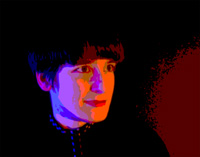 Laura Watts (Centre for Science Studies, Department of Sociology, Lancaster University)
Laura Watts (Centre for Science Studies, Department of Sociology, Lancaster University)
Liminal Futures: Landscapes of Innovation in the High-Tech Industry
The future of access to information and telecommunications is often talked about as anywhere and everywhere, as pervasive and ambient, ubiquitous and always on. Yet the high-tech industry is not everywhere. Its marketing headquarters and Research & Development sites are located in certain places and not others: Silicon Valley, the Thames Valley, Silicon Fen, historic proximity to the defence industry, and within easy reach of global transport hubs such as Heathrow. The landscapes of high-tech industry, the everyday places where the future gets made in design studios and in business strategy meetings, are therefore very particular.
The future is made in everyday practices and places, from PowerPoint presentations to notes made whilst on a train. The future is situated in practices and places; it's always local to the landscapes of its rehearsal and ongoing production. Future-making is entangled in landscapes. For example, the future of anywhere and everywhere telecommunications is made in landscapes that do not resist telecoms infrastructure, where radio signals propagate easily, where the proliferation of ICTs are at their densest, and where a future of pervasive information access seems an unimaginative, obvious possibility.
But what of other landscapes? What of landscapes of mountain and sea, which resist the propagation of radio signals and optical fibre? What futures might be imagined in places where anywhere and everywhere do not hold for television or telecoms, but where local specificity and mutability are crucial? Different landscapes might participate in the production of different futures.
Set in contrast to the mobile telecoms industry near London, this paper will explore the generative potential of Orkney, an island archipelago off the north coast of Scotland, as a site for future-making in the high-tech industry. Not only does its topography resist a future of ubiquitous access, but its temporality is also radically different to those at the centre of the industry. For instance, high-tech companies on Orkney work within, not a dense proliferation of mobile phone masts, but a dense proliferation of five thousand year-old prehistoric monuments, from stone circles to chambered tombs; their everyday experience includes these enduring technologies.
This is not about an ethnography of users, but an ethnography of high-tech designers and managers and their creation of user futures. It concerns future- making practices and processes inside industry, and how they might be done differently in different places.
Rather than remote landscapes being at the edge of the high-tech industry, this paper proposes that such landscapes can participate at the centre of future-making. Through dialogues between what is thought of as the periphery and the hub, between universal futures and liminal futures, perhaps more innovative and more locally specific high-tech futures might be imagined and made possible.
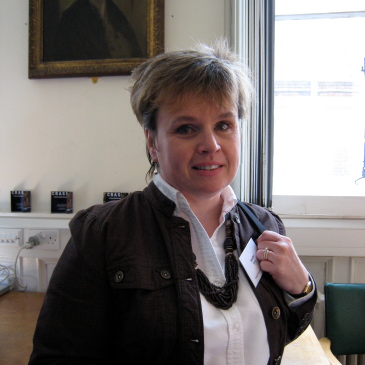 Jennifer Baird (Canadian Heritage Information Network (CHIN))
Jennifer Baird (Canadian Heritage Information Network (CHIN))
From 'Question the Authority' to 'Question Authority!'
The re-use of cultural content for multiple purposes has been a mainstay of the work of the Canadian Heritage Information Network (CHIN, www.chin.gc.ca), founded in 1972. CHIN, an agency of the federal Department of Canadian Heritage, works with museums and heritage organizations as a centre of excellence that provides a visible face to Canada's heritage through the world of networked information. Its mission is to promote the development, the presentation and preservation of Canada's digital heritage content for current and future generations of Canadians.
In its initial decades, CHIN housed content contributed by Canadian museums, and acted as a link between site visitors and the content: site visitors sent their queries via e-mail to CHIN, and CHIN or a museum, as 'authority', answered the questions. Social media have changed everything, and as the authority of central institutions is questioned, site visitors now have the means to create their own knowledge bases, drawing on the riches of museums and their specialists, and on each other.
CHIN and the Canadian museum community have developed several initiatives that allow users to engage in heritage content and with each other through a single point of access to content housed in disparate museums. With social media and other emerging technologies, these initiatives are now realizing their potential and allowing the re-use of this authoritative content in unexpected ways.
Of particular relevance to this conference are three recent projects, each of which begins with content from museums and heritage organizations:
* Artefacts Canada, on the CHIN site, the freely available online inventory of Canadian museum collections, consisting of 3.5 million object records and approximately 630,000 images from more than 340 museums and heritage organizations. Artefacts Canada is being redesigned and will include fields to document and share intangible cultural heritage and allow users to share their knowledge and stories with each other.
* Tipatshimuna: Innu stories from the land (www.innustories.ca) is a website developed in partnership with Innu communities in Newfoundland & Labrador and Quebec (Canada), museums, and government agencies. Launched in 2005, the site's architecture was designed to allow the integration of museum collections within and outside Canada, and this year welcomes the first international partner. Beginning as an educational website, it has the means to become a portal to Innu heritage.
* Aboriginal Cultural Knowledge Exchange is a pilot project within the Agora learning initiative of the Virtual Museum of Canada (www.virtualmuseum.ca). In collaboration with Elders, teachers across Canada's vast north develop and share lesson plans and hands-on activities with each other. Using local collections and social media, students learn about and share the skills that allowed their ancestors and families to survive. This increases their understanding of, and respect for, the knowledge of their Elders and of their culture and traditional way of life.
* The Canadian Heritage Information Network has been a partner with many Aboriginal communities across Canada, collaborating on more than twenty virtual exhibitions in the Virtual Museum of Canada that document, promote, share, and present the riches of Canada's First Nations, Metis, and Inuit.
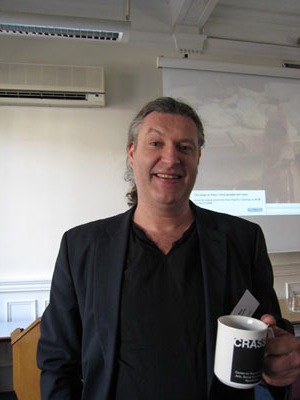 Bart Barendregt (Anthropology, Leiden University)
Bart Barendregt (Anthropology, Leiden University)
Mobile modernities in contemporary Indonesia
In Indonesian society modernity is increasingly defined in terms of mobility, including social mobility but also the use of mobile media. Many are puzzled by the technology behind cell phones and have been reporting of phones haunted by ghosts. Indonesian mobile modernity has produced its own forms of resistance, ranging from its association with terrorism and political subversion, to other moral anxieties along the seamy side of the information society. The ongoing project the mobile phone is has as the same time led some Muslim groups to question how cellular technology can be 'Islamized'. We therefore need to scrutinize the often powerful discourse surrounding the mobile phone's alleged empowering qualities and the possibilities promised by the industry, partly by linking it to the wider context into which the phone is at present incorporated in Indonesian society, and partly by looking at the mobile's introduction to some of the margins of Indonesian society. If it comes to mobile communication, the country promises to be one of the fastest growth-markets, and yet Indonesian society seems to offer different stories, highlighting strategies used by those hitherto excluded from mobile modernity as to catch up with the information age. Nowadays, in Indonesia even supposedly vulnerable groups such as Java's urban poor, overseas workers and often-illiterate peasants do have access to new mobile media, hoping to participate in what many view as a mobile modernity. The next step in the cellular boom is the long awaited switch to a new technology, broadband CDMA, making possible games, entertainment and mobile Internet. At the same time, it is not these latest technologies or models that should be held responsible for the present growth of the mobile market in Indonesian society, but rather the participation of hitherto digitally less-well-off groups; market women, pedicab drivers but also school children and the older generation. Such leapfrogging is in Indonesia made possible by inexpensive CDMA packages, shops selling phones through intricate credit deals, but more importantly by the vast supply of a black and semi-legal market selling cheap second hand phones. Other strategies include those of cell phone hackers, and crash courses for so-called 'cellular doctors' that teach how to 'cannibalize' phones by using components of older and no longer used mobiles; one phone literally eats the other. These and other alternatives contribute to the trickling down of mobile technology to the lower strata of society. Focussing on the challenges these groups face, provides us with different, little studied interpretations of a much hyped mobile modernity.
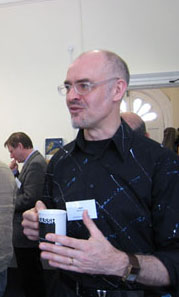 Alan Blackwell (Computer Lab, Cambridge)
Alan Blackwell (Computer Lab, Cambridge)
The Crucible network for research in interdisciplinary design was established in 2001, in order to encourage collaboration between technologists and researchers in the arts, social sciences and humanities. After more than 30 projects with hundreds of collaborators, a clear pattern of concerns has emerged, identifying questions of morality, embodiment and innovation as the "bottom up" problems that emerge when new windows are inserted into the walls of technology's black boxes.
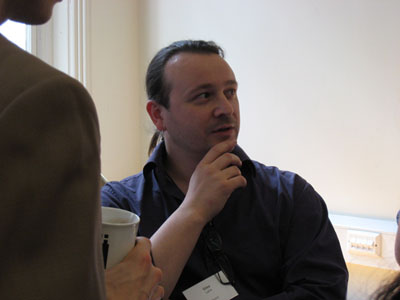 Giles Lane (Proboscis)
Giles Lane (Proboscis)
Public Authoring, Scavenging and Agency
Giles Lane will give an overview of some of Proboscis' projects, tools and techniques exploring the use of emerging and traditional technologies by grassroots communities to 'author' their own ecologies of knowledge, tradition, information and experience.
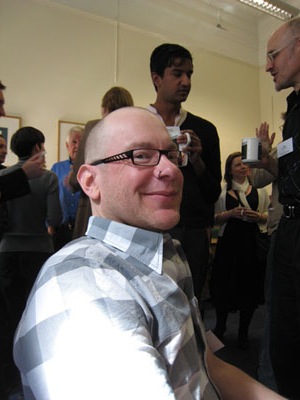 Gregers Petersen (Copenhagen Business School)
Gregers Petersen (Copenhagen Business School)
Wireless technology, subversive politics
Making the assumption that people seem to find their own uses for new objects and ideas and assuming the existence of a relationship between technology and form of social organization twists ethnographic inquiry into new (or old) directions. This presentation will move and wind its way into, and through, the lines that weave together wireless technology and subversive politics. The setting is Berlin, Germany, in the present. The subject is the subversion of wireless network devices, the subsequent reality of a new wireless networking paradigm, and creation of free information infrastructure by a social structure know as Freifunk. Freifunk came into being from a background of political/technical (h)activism, squatters movements, and the re-merging of the two half's of Berlin/Germany. During the 90's, Berlin was a focal point of infrastructure development, and nothing was too new or too expensive. Then the big year 2k bubble blew. This left large geographical areas of the city with extensive internet-infrastructure on the ground, but no one to operate them, and hence no one to offer broadband-connections to a general consumer. People first tried to be heard, to voice their needs, then they simply turned their backs and found their own solution. The result has become an autonomous mesh-networking-cloud which now covers extensive parts of the city, offering free internet access and services to everyone who connects (with the right protocol). Similar mesh-clouds are spreading across Germany and Europe and they are racing around the globe on a quest which constantly creates new budding nodes, from Asia to Africa and Latin America to the Pacific.
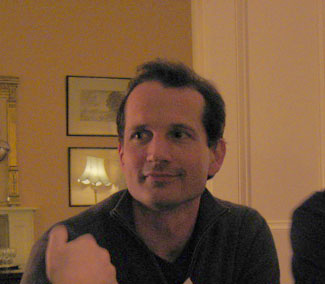 Jon Ippolito
Jon Ippolito
Whose Tool Is This Anyway? Art and Creative Misuse Jon Ippolito (University of Maine)
Still Water co-director Jon Ippolito takes a look at emblematic cases of the transition from subversion through conversion to development in connections between art and industry in the last fifty years.
Subversion has been a common strategy of art in emerging media, dating back arguably to the Renaissance. Examples of the artistic misuse of existing technologies from our period are plentiful, as made famous by Nam June Paik's rewired electronics from the 1960s. Examples of conversion are harder to come by: few companies chose to release consumer products based on Paik's disgorged televisions, although features of some prominent 21st- century applications such as Adobe Illustrator and Google Earth do reflect the clear influence of artists such as Adrian Ward and Art+Com from the 1990s.
If we look instead at the proactive adoption of an artistic approach (development) rather than the retrospective adoption of an artistic feature (conversion), the salient example is today's so-called "Web 2.0" phenomenon. Web 2.0 hallmarks such as user participation (YouTube, Flickr, blogs), rich user experiences (AJaX, Google Maps), and radical trust (Wikipedia) have precedents in early Internet artworks such as Refresh, Web Stalker, and DeskSwap. The Pool pool.newmedia.umaine.edu is an example of an artist- designed application that incorporated all three strategies years before the term "Web 2.0" existed.
History shows that new media art's promotion and appropriation by established hierarchies can either reinforce or destabilize the status quo, depending on the speed, breadth, and audience for this conversion.
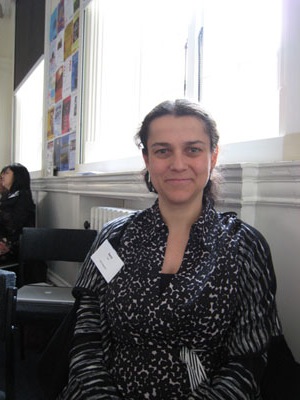 Daria Loi (Intel Research)
Daria Loi (Intel Research)
Bio: With a background in Architecture and a PhD in Design/Management from the Royal Melbourne Institute of Technology, Daria Loi is Design Researcher in the User Experience Group (Digital Home, Intel Corporation), where she develops and tests usage models and design concepts for domestic environments. Before joining Intel she has worked as architect/designer in Italy; correspondent for Italian and Australian design publications; researcher for Australian Research Council projects; researcher at the Interactive Information Institute and in the Australian Federal Government funded Creator-2-Consumer Project; coordinator and lecturer in the Industrial Design program at RMIT University; Visiting Academic at IADE, Portugal; and Senior Research Fellow at RMIT Globalism Institute. Daria has run workshops and presented her work in Europe, Australia, Canada and the USA over the past decade and she is committee member and reviewer for a number of journals, institutes and conferences, including: Participatory Design Conference; Design Principle and Practices: an International Journal; The Center for Children's Learning; Journal of Computers in Human Behavior; Design Research Society; Research into Practice; and CHI. Her practice revolves around: participatory design; practice-based inquiry; HCI; post- disciplinarity; collaborative environments and practices; services; and creative management. Articles, papers and more at: www.darialoi.com